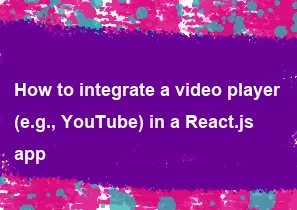How to integrate a video player (e.g., YouTube) in a React.js app

Integrating a video player, such as YouTube, into a React.js app can be achieved using either the YouTube Iframe Player API or by using a pre-built React component library designed for embedding videos. Here, I'll demonstrate how to integrate a YouTube video using both approaches:
Using YouTube Iframe Player API:
Install Required Libraries: First, install the
react-youtubepackage, which is a simple wrapper around the YouTube Iframe Player API.bashnpm install react-youtubeCreate a Component: Create a component to render the YouTube video player.
jsximport React from 'react'; import YouTube from 'react-youtube'; const VideoPlayer = ({ videoId }) => { const opts = { height: '390', width: '640', playerVars: { autoplay: 0, }, }; return <YouTube videoId={videoId} opts={opts} />; }; export default VideoPlayer;Use the Component: In your application, import and use the
VideoPlayercomponent, passing the YouTube video ID as a prop.jsximport React from 'react'; import VideoPlayer from './VideoPlayer'; const App = () => { return ( <div> <h1>YouTube Video Player</h1> <VideoPlayer videoId="your-youtube-video-id" /> </div> ); }; export default App;
Using a Pre-built React Component Library (ReactPlayer):
Alternatively, you can use a pre-built React component library like react-player, which supports various video sources including YouTube, Vimeo, and more.
Install Required Libraries: Install the
react-playerpackage:bashnpm install react-playerCreate a Component: Create a component to render the video player.
jsximport React from 'react'; import ReactPlayer from 'react-player'; const VideoPlayer = ({ url }) => { return <ReactPlayer url={url} />; }; export default VideoPlayer;Use the Component: In your application, import and use the
VideoPlayercomponent, passing the YouTube video URL as a prop.jsximport React from 'react'; import VideoPlayer from './VideoPlayer'; const App = () => { return ( <div> <h1>Video Player</h1> <VideoPlayer url="https://www.youtube.com/watch?v=your-youtube-video-id" /> </div> ); }; export default App;
Notes:
- Replace
"your-youtube-video-id"with the actual YouTube video ID. - For the
react-playerlibrary, you need to provide the full URL of the YouTube video. - Both approaches allow you to customize the player's appearance and behavior according to your requirements. Refer to the respective documentation for more options and configurations.
-
Popular Post
- How to optimize for Google's About This Result feature for local businesses
- How to implement multi-language support in an Express.js application
- How to handle and optimize for changes in mobile search behavior
- How to handle CORS in a Node.js application
- How to use Vue.js with a UI framework (e.g., Vuetify, Element UI)
- How to configure Laravel Telescope for monitoring and profiling API requests
- How to create a command-line tool using the Commander.js library in Node.js
- How to implement code splitting in a React.js application
- How to use the AWS SDK for Node.js to interact with various AWS services
- How to use the Node.js Stream API for efficient data processing
- How to implement a cookie parser middleware in Node.js
- How to implement WebSockets for real-time communication in React
-
Latest Post
- How to implement a dynamic form with dynamic field styling based on user input in Next.js
- How to create a custom hook for handling user interactions with the browser's device motion in Next.js
- How to create a custom hook for handling user interactions with the browser's battery status in Next.js
- How to implement a dynamic form with dynamic field visibility based on user input in Next.js
- How to implement a dynamic form with real-time collaboration features in Next.js
- How to create a custom hook for handling user interactions with the browser's media devices in Next.js
- How to use the useSWRInfinite hook for paginating data with a custom loading indicator in Next.js
- How to create a custom hook for handling user interactions with the browser's network status in Next.js
- How to create a custom hook for handling user interactions with the browser's location in Next.js
- How to implement a dynamic form with multi-language support in Next.js
- How to create a custom hook for handling user interactions with the browser's ambient light sensor in Next.js
- How to use the useHover hook for creating interactive image zoom effects in Next.js